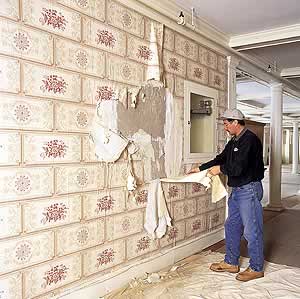
Wallpaper, Wallpaper Removal
If the paper comes off does it leave the backing or glue on the wall? If the paper doesn't come off, does it absorb water or wallpaper remover solution? If it doesn't, you'll need to perforate or score.
by Susan Brimo-Cox
always be sure of what you’re getting into. This is especially important when the job is to remove wallcovering. Experts in the industry caution that you should never make assumptions. Always, test first!
Louis Ligeri, owner of Wallpaper Removing Specialists Co. in Roslyn, N.Y, has more than 30 years experience tackling challenging projects. He uses a multi-step process: “First, try to pull it off.” If the paper comes off, “does it leave the backing or glue on the wall?” If the paper doesn’t come off, “does it absorb water or wallpaper remover solution?” If it doesn’t, “you’ll need to perforate or score.”
By working through these various stages of removal — from simple to more elaborate — Ligeri says you’ll have a good idea of the scope of the job.
“Test in the middle of the wall, in the center of the room — not along the baseboard or along a doorjamb,” recommends Michael Zekich, owner of Safe & Simple Wallpaper Removal in Pasadena, Calif. Zekich, who specializes in wallcovering removal, says, “We try to remove a 6-inch square area with removal solution. We wet the paper and backing, let it rest, and then see how difficult it is to remove.”
Sometimes the type of wallcovering is an indicator. Ligeri reports some of the easiest papers to remove include dry-strippable, fabric-backed vinyls, paper-backed vinyls and English papers. Generally, he says, “If the surface covering absorbs, it’s easy to remove. If it doesn’t absorb, chances are the surface has to be scored or perforated — then you have a job ahead of you.”
Sometimes what you can’t see presents the greatest challenge.
“Look at the type of paper and the type of house,” cautions Pat Niehaus, a consultant and owner of The Wall Doctor in Bayonet Point, Fla. “Is the wallcovering on plaster or drywall? Is it old plaster? Old drywall?” Knowing something about the age of the house can tell you something about the substrate and how it may have been prepared before the wallcovering was hung.
Zekich agrees. The difficulty of the wallcovering removal task often depends not so much on the paper, but the surface it’s built on, he says. “A well-painted or primed substrate [usually means] you’ll have easier removal than from unprimed surfaces.” In newer homes, removal is more difficult “primarily because of the more accepted poor-quality wall preparation.”
Looking for a real challenge? Try removing a pre-pasted paper that was installed with additional adhesive. These one-of-a-kind adhesives — “home-made brews” — are very difficult to remove, reports Zekich. “A real issue is installers and consumers that do not install wallcoverings according to product directions.”
You need great quantities of patience when removing wallcoverings, but there are a variety of aids that can make the job easier.
One of the most misunderstood items is wallpaper removal solutions, says Frank Nicholson, Western regional sales manager of Tampa, Fla.-based Gardner-Gibson Inc. “Most people don’t understand what a removal solution is. They are chemicals, known as surfactants. When mixed with water, they lower the surface tension of the water, which allows the water to penetrate the paper.” By making water “wetter,” these products allow moisture to pass through the paper pores more easily. |

